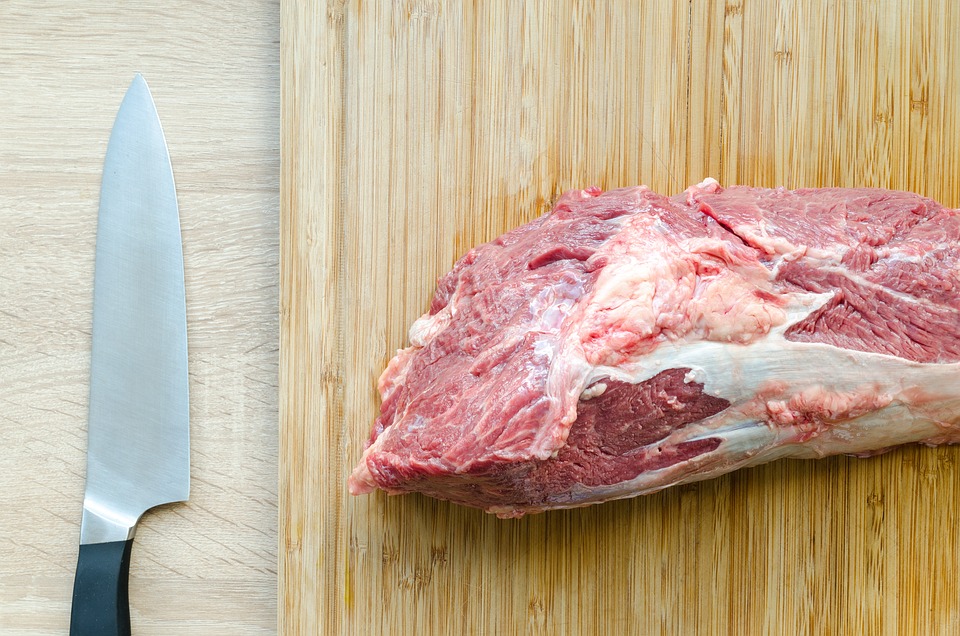Steak can be kept fresh until you’re ready to consume it by freezing. However, when it comes time to defrost your steak, you must make sure you do it correctly because doing it incorrectly can negatively affect the meat’s flavor and your health. Here are the ideal methods for defrosting steak and other beef cuts and the incorrect methods.
In a pinch, your microwave’s defrost setting could seem alluring, but if you care about your steak and want to treat it well, you won’t use it. Steak doesn’t react well to sharp temperature fluctuations, and defrosting steak in the microwave is likely to drain it of its juices, destroying its flavor and texture and giving you a rough chew that will dissatisfy you.

What is Steak?
Generally speaking, a beef cut that has been cut against the muscle’s grain is referred to as a steak.
Take a careful look at a chunk of beef if you’re curious about the grain. Throughout the cut, there should be undetectable lines going in a single direction. The muscle grain is that.
There is no one specific part of the cow from which a steak is produced. Steaks are sliced from a variety of pieces. They come in various sizes and shapes, making picking one at the butcher counter difficult.
How to Defrost Frozen Steak?
Steaks and most meats should be kept at safe temperatures as they thaw to prevent the entry of fast-growing bacteria that could spoil your meal. Between 5°C and 60°C is the “danger zone” that you want to stay out of because this is essentially vacation weather for germs, making thawing meat at these temperatures a serious source of food illness.
Unfortunately, the fastest and safest way to defrost steak is to put it in the refrigerator overnight. This won’t affect the steak’s flavor or texture, but it will preserve the steak at a temperature that keeps dangerous bacteria from establishing a foothold.
Depending on the cut’s thickness, you should give your frozen steak at least 12 hours in the refrigerator to defrost. Most meat will take 18 to 24 hours to thaw thoroughly, and a very thick chunk may need up to 30 hours. Make sure your steak is placed on a plate to catch any juices that may spill when you put it in the refrigerator.
The most efficient (and hands-off) method of defrosting steak is in the refrigerator, although it takes some preparation. Try setting a reminder in your phone at the beginning of the week to take that steak you’ve been admiring out of the freezer.
When your steak has been chilled for at least 12 hours, take it out and give it the touch test. It should feel solid to the touch, with some give and no icing that can be seen. Put a meat thermometer into the thickest section of the cut for more assurance; if the temperature is four °C or lower, you’re set to go. If the temperature rises beyond four °C, it enters the danger zone, and you may need to check to see if your refrigerator is functioning properly.
Tips for Freezing Steak Properly
The ideal method for freezing beef is to vacuum-pack it and promptly freeze it at a very low temperature. You risk degrading the quality of the beef and exposing it to freezer burn if it is loosely wrapped and frozen slowly (or barely frozen).
The water in meat develops into ice crystals that grow huge and rip apart the fiber or muscle cell structure as it is progressively frozen. Upon freezing, this damage causes moisture loss.
However, even smaller ice crystals are produced when meat is frozen quickly (using techniques like blast freezing and temperatures well below zero). This prevents your steak from having that mushy texture from slow freezing, resulting in less water loss when thawing.
The Best is Uncooked
Although frozen cooked steak can be safely stored, it is always preferable to store frozen uncooked meat.
This is because the steak retains many nutrients and liquids when uncooked; therefore, cooking it after frozen won’t result in any observable flavor differences.
Substitute It
Avoid overcooking steak since it will become tough and rubbery. We suggest slightly undercooking a cooked steak if you plan to freeze it. Therefore, if you prefer your steak medium, cook it just long enough to leave some raw. By doing this, you will avoid overcooking it when you reheat it.
Only Ever Freeze
Steaks should never be frozen more than once. You should portion your steak before freezing it if it is a particularly large cut you don’t believe you can eat all at once. This will allow you to take out smaller parts whenever you want and prevent you from wasting your steak.
How can you Avoid Freezer Burn with your Steak?
Don’t be alarmed when you notice how severely frozen steak quality is impacted by freeze burn. You can freeze your steak in several different ways. Don’t pass it up, please.
Be sure to carefully wrap the steak, attempting to remove as much air as possible from the container.
The smallest package that will fit the steak should be used. The smaller it is, the less probable air will get inside the container.
Somewhere in the freezer, put a cup of water. It will assist in adding moisture if you do this. After 2-3 months, switch out other cups.
Before freezing, completely submerge the steak. The steak will avoid drying out if you add moisture to it.
Rewrap the steak when you have stored it for too long.
Important Tips for Cooking Steak
Purchase the Best Steak for the Task
Are you using the grill to feed a hungry crowd? There is a steak for practically every cooking or dining situation because it is available in various sizes and price points. Your greatest options are a skirt or a flannel. Purchase a fillet or porterhouse to serve two people on a date. For a group dinner, order sirloin or rib eyes.
Well-Seasoned Steak
A liberal sprinkle of salt before cooking enhances the flavor of every type of steak. Sirloins and other thick steaks should be seasoned a few days in advance. Quick marinades can also be used to season flank and skirt steaks.
Determine When Something is Done with a Thermometer
A digital probe thermometer is the greatest equipment you can purchase for grilling a steak. You’ll get a quick read on the steak’s doneness and be protected from overcooking.
It’s Not Required to Take a Nap
According to conventional belief, all steaks should be rested before being cut into slices and served. However, anecdotal evidence suggests that resting doesn’t produce a juicier steak. Additionally, a warm steak frequently tastes a little juicier.
Always cut your steak against the grain, which means you should divide the visible fibers in half to shorten them and keep the meat soft.
How to Recognize Spoiled Steak?
Foul Smell
Generally, fresh steak does not have the best fragrance, and some people find this odor offensive until the meat is cooked.
However, simply smelling the meat can tell the difference between a fresh raw steak and a raw steak that has gone rotten.
A steak still fit for consumption smells different from the one you should toss.
A ruined or rotten steak will have a strong stench that is very different from the aroma of a fresh, uncooked steak.
In contrast, the rotten steak will smell strongly like ammonia and be easy to detect.
Dry Steak
A dry steak could indicate that the meat has spoiled.
So, when you look at your steak, does it appear shriveled or dried, and is it dry to the touch?
Although it may not guarantee that you will contract a foodborne illness if you eat the steak, dryness and lack of juice will affect the flavor and signal that the meat is past its prime.
If your steak looks like this, you should eat it right away because else it will spoil. If you cannot consume your dry-aged steak within the next day, throw it away or freeze it.
Slimy Texture
To avoid food poisoning, look for a slime-like layer on the surface of the steak to determine whether it is rotten.
When you pick up the steak, you will see and feel this slime, which is a telltale sign that your steak is poor, and you should throw it out.
Your steak will appear shinier than it should be due to the clear or yellowish slime that covers it.
When you touch this slime, it will feel slick or sticky. This slime usually appears on the damaged steak a few days before mold grows.
Is Daily Consumption of Steak Harmful to your Health?
Steak is high in many nutrients but has a lot of calories and fat. Because of this, I was regularly eating steak may result in a quick increase in weight and even high levels of harmful cholesterol.
According to several research studies, eating red meat frequently may increase your risk of developing cancer, cardiovascular disease, and early mortality. However, the red meat used in this research was not grass-fed but commercial. Therefore, remember that not all red meat is created equal and that this research also paid attention to regular eating.
Another thing to consider is the possibility that red meat’s harmful effects on your health result from the processing—cooking—of the meat. This is because certain chemicals generated during frying are bad for your health and may even be cancer-causing.
As a result, grilling or broiling your steak is the healthiest method because it reduces the number of hazardous compounds created.
Customers cited different preparation techniques: “In the end, it depends on the preparation. “Steak or roast is better for your health than beef done with a sauce” (British lady, 40); “Whether you prepare your meat with a lot of butter or not” (French man, 43); and “If you prepare it in a deep fat fryer, then you know that it is not very healthy” ” (French woman, 60 years). Interestingly, the “unhealthy” elements had less to do with the beef itself than the “sides” and ingredients used in the preparation, such as butter, margarine, oil, and sauce.
Conclusion
When you buy a frozen steak, it’s very important to defrost it quickly so it can be used. This is especially true if you plan on cooking it. You can use the microwave or a bowl to do this. If you don’t, you may end up with a cold piece of steak you can’t eat.
A bowl of cold water is easy to thaw frozen steak. However, it would be best to take caution when using this method. It can cause harmful bacteria to grow, which can spoil your meal. It can also result in hot spots in the meat. If you are concerned about the safety of thawing in water, you should consider thawing your steak in the fridge. It is safer to use this method because it prevents harmful bacteria from forming. In addition, it is quicker. The refrigerator will keep your steak fresh for about a week.
